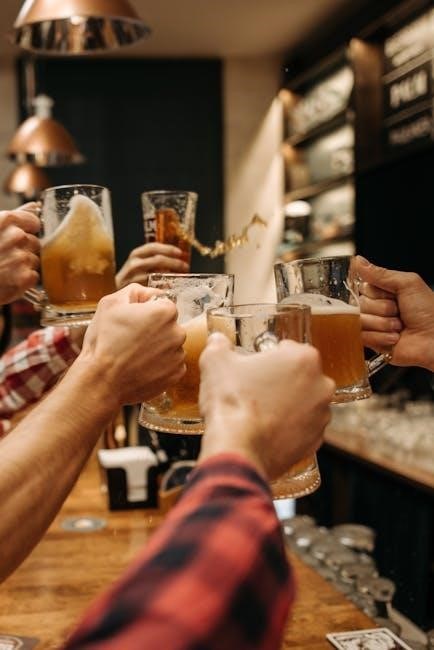Beer Pong is a popular social drinking game involving skill and strategy. Players toss ping pong balls into cups filled with beer, aiming to outscore opponents. Its rules vary but focus on fair play and safety, making it a fun, competitive activity for gatherings and events worldwide.
1.1 Overview of the Game
Beer Pong is a popular social game where two teams take turns tossing ping pong balls into cups filled with beer. The cups are arranged in a triangular formation, and the objective is to eliminate all of the opposing team’s cups. A made shot results in the removal of the targeted cup. The game ends when one team has no cups remaining, declaring them the winner. Variations in rules and cup arrangements exist, but the core concept remains consistent across all versions.
1.2 Importance of Rules in Beer Pong
Rules are essential for ensuring a fair and enjoyable Beer Pong experience. They prevent disputes, establish clear guidelines, and maintain balance among players. Key rules like the elbow requirement and shot time limits ensure fairness and organization. Adhering to these guidelines promotes safety, sportsmanship, and a positive atmosphere, making the game accessible and fun for everyone involved.

Equipment and Setup
Beer Pong requires two players per team, 22 cups (20 for beer, 2 for water), and two ping pong balls. Cups are arranged in a triangle formation, with each team aiming to eliminate the opposing team’s cups to win the game.
2.1 Number of Players and Teams
Beer Pong is typically played with two players on each team, making a total of four participants. Teams can also vary, with some games featuring one-on-one matches or larger groups. The standard setup involves two players per team, ensuring balanced gameplay and fair competition. This format allows for strategic coordination and camaraderie among teammates.
2.2 Required Materials (Cups, Balls, etc.)
The essential materials for Beer Pong include 22 party cups (20 for beverages and 2 for water), a smooth table, and two ping pong balls. Each cup should be filled with a small amount of liquid. The table is typically 8 feet long, and the balls are standard ping pong size. These materials ensure a uniform and fair gaming experience.
2.3 Table and Cup Arrangement
The table is typically 8 feet long, with cups arranged in a triangular formation on each end. Each side has 10 cups, filled with 1/3 of a beverage, spaced 6 inches apart. The opposing cup racks are placed 6 inches from the table’s edge, ensuring a clear throwing path. Variations may use fewer cups for quicker games, like 6 cups per side.
Shooting Rules
Beer Pong shooting rules ensure fair play, including elbow position, time limits, and legal throws. These guidelines maintain game integrity and promote competitive enjoyment for all players.
3.1 Elbow Rule (Elbow Behind the Table Edge)
The Elbow Rule requires players to keep their shooting elbow behind the table edge. Breaking this rule results in the shot not counting, ensuring fairness and consistency in gameplay. This rule is often debated but is crucial for maintaining the integrity of Beer Pong, as it prevents unfair advantages and promotes a level playing field for all participants.
3.2 Time Limits for Shots
Players must release the ball within a specified time limit, typically 30 seconds per shot. Failure to do so results in a missed attempt. This rule ensures gameplay flows smoothly and prevents excessive delays. Some variations allow a 60-second limit per team’s turn, promoting timely gameplay while maintaining excitement and fair competition among participants.
3.4 Blocking and Trick Shots
Players can legally block incoming shots with their hands or objects, but interference before the ball lands is prohibited. Trick shots, such as bouncing or spinning the ball, are allowed and often rewarded with additional penalties for the opposing team. Creative techniques enhance gameplay excitement while adhering to core rules, ensuring fair and dynamic competition.

Fouls and Penalties
Fouls, such as moving cups or interfering with shots, result in penalties. Common penalties include drinking the contents of a cup or losing a turn, ensuring fair play and accountability in the game.
4.1 Common Fouls in Beer Pong
Common fouls include moving or touching cups during a shot, elbow rule violations, and premature removal of cups. These actions disrupt gameplay and are penalized to maintain fairness and sportsmanship, ensuring all players adhere to established rules for a balanced and enjoyable experience.
4.2 Consequences of Fouls
Fouls result in penalties, such as replaying shots or drinking from the violated cup. Severe or repeated fouls can lead to disqualification, ensuring adherence to rules and maintaining the integrity of the game. These consequences enforce fair play and uphold the competitive spirit of Beer Pong, keeping the game enjoyable for all participants.
Winning the Game
Winning occurs when all opponent’s cups are eliminated or if special rules like “King’s Cup” are activated, ensuring the game concludes decisively.
5.1 Eliminating Opponent’s Cups
Eliminating an opponent’s cups involves successfully landing ping pong balls in them. Once a ball enters a cup, the opposing team must drink its contents, and the cup is removed. This progression continues until one team has no cups left, securing their victory and ending the game.
5.2 Special Rules (e.g., “King’s Cup”)
The “King’s Cup” rule adds excitement to the game. When a team has only one cup remaining, it is deemed the King’s Cup. If a player lands a shot in this cup, their team instantly wins the game. This rule accelerates the conclusion and adds an element of strategy, making the final moments intensely competitive and thrilling for all players involved.
Variations of Beer Pong
Beer Pong has various adaptations, such as different cup arrangements or alternate rules, allowing players to customize the game for faster play or increased creativity.
6.1 Different Cup Arrangements
Beer Pong cup arrangements vary widely, with common setups including 6, 10, or 20 cups. Cups can be placed in triangular, pyramidal, or linear formations. House rules often dictate the arrangement, allowing for creativity and customization. Some variations use fewer cups for quicker games, while others add complexity with unique patterns, enhancing gameplay dynamics and challenging players’ skills.
6.2 Alternative Rules for Faster Games
To speed up Beer Pong, players can use alternative rules like “1-ball” games, where each team shoots one ball per turn. Another option is “no rebuttal,” eliminating the final redemption shot. These adjustments reduce gameplay duration while maintaining excitement, making the game more dynamic and suitable for larger groups or time-sensitive events and tournaments.

Etiquette and Safety
Always drink responsibly and maintain a clean environment. Spilled beer should be wiped up immediately to prevent accidents, ensuring a safe and enjoyable experience for all players and spectators.
7.1 Responsible Drinking Guidelines
Responsible drinking is essential in Beer Pong. Players should pace themselves, stay hydrated with water, and avoid excessive alcohol consumption. Never force others to drink, and ensure all participants are of legal drinking age. Designated drivers or alternative transportation should be arranged beforehand to prioritize safety and prevent impaired driving.
7.2 Maintaining a Clean and Safe Environment
Keep the playing area clean by promptly cleaning spills and removing empty cups. Ensure sturdy tables and proper lighting for safety. Avoid overcrowding and supervise intoxicated players to prevent accidents. Provide water for hydration and maintain hygienic conditions for cups and equipment to ensure a safe and enjoyable game environment for everyone involved.
Tournament Rules
Tournaments follow standardized rules to ensure fairness. Official setups include specific cup arrangements and team structures. Rules like the elbow rule and shot timing are strictly enforced.
8.1 Official Tournament Setup
An official tournament setup requires a standardized table with 10 cups per team, arranged in a triangular formation. Each cup is filled with 1/3 water or beer. Two ping pong balls are used, and teams alternate shots. The setup ensures fairness and consistency across all matches, adhering to established rules for competitive play.
8.2 Bracket and Scoring Systems
Beer Pong tournaments often use single or double elimination brackets to determine winners. Scoring is based on the number of cups eliminated, with bonus points for strategy and performance. The team with the most points or fewest remaining cups advances. Special rules, like the “King’s Cup,” add complexity and excitement to the competition, ensuring fair and thrilling matchups.

Additional Resources
Downloadable PDF guides and online communities provide comprehensive rule sets and strategies for Beer Pong. Visit official forums and websites for detailed resources to enhance your gameplay experience.
9.1 Downloadable PDF Guides
Official Beer Pong rule sets are available as downloadable PDFs, offering comprehensive guides for setup, gameplay, and tournament rules. These resources, such as TheOfficialRulesofCanadianBeerPong and BeerBaller guides, ensure clarity and consistency for players. They cover equipment requirements, shooting rules, fouls, and special scenarios, making them essential for both casual and competitive play. Download these PDFs from trusted sources to refine your Beer Pong experience.
9.2 Online Communities and Forums
Online communities and forums dedicated to Beer Pong offer valuable resources, discussions, and shared experiences. Platforms like Reddit and Facebook groups host active discussions on rules, strategies, and variations. Players can share downloadable PDF guides, ask questions, and learn from experts. These communities foster engagement, helping enthusiasts refine their gameplay and stay updated on the latest trends and tournament rules.
Beer Pong is a fun, social game requiring skill and strategy. By following the rules and prioritizing safety, players can enjoy a competitive and memorable experience. Share the rules with others to ensure everyone plays fairly and responsibly.
10.1 Final Tips for Enjoying Beer Pong
To maximize enjoyment, practice your throwing technique and stay hydrated. Always respect your opponents and maintain a clean playing area. Keep the game light-hearted and fun, ensuring everyone drinks responsibly. Know your limits and never pressure others to drink more than they’re comfortable with. Happy ponging!
10.2 Encouragement to Share Rules with Others
Sharing Beer Pong rules ensures everyone knows how to play, promoting fairness and fun. Downloadable PDF guides make it easy to distribute rules to participants, preventing disputes and enhancing the overall experience. Encourage others to share these guidelines to keep the game enjoyable for all!